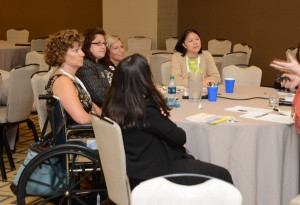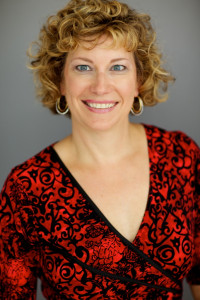-
A Seated Perspective on Inclusive Meetings
 No, this isn’t another article about getting “that” seat at the table, rather about my recent eye-opening (and arm tiring) 5 hour experience as part of a conference session entitled “Inclusive Hospitality.”
No, this isn’t another article about getting “that” seat at the table, rather about my recent eye-opening (and arm tiring) 5 hour experience as part of a conference session entitled “Inclusive Hospitality.”In the pre-session, volunteers could choose a variety of ways to experience the conference – my choice was a wheelchair.
My first challenge was where to put my bag. I obviously couldn’t carry my tote on my shoulder and it wasn’t practical to wedge it next to me on the seat. Someone offered to hang it on the back of my chair – that worked, but I realized that now the contents of my tote were exposed to anyone walking behind me. So I grabbed my phone/wallet and kept that next to me, just in case. I started my journey pushing myself (great arm workout!), figuring that I could make it to my next session without assistance. I made it down the hallway, but found out that wheeling yourself across a carpet was easier than across the marble floor (sounds counter-intuitive I know). When I got to my destination I accepted an offer of help to wheel me into the room. Now the decision of where to sit – the room was set crescent-style with banquet rounds and two rows of chairs in the back. I opted for the back of the room as navigating in between the tables seemed daunting (and I didn’t want to attract attention). Someone offered to move a few chairs to allow me to sit comfortably and not block access of others.
Now time for lunch – I headed over with some friends and this time accepted an offer to be pushed. We arrived to find the tables near the doors full, so one in our group went ahead to scout out seats; of course they were on the other side of the room. After finding an aisle that was wide enough and a free table, I needed to find the optimal seat at the table – one without legs right underneath so I could pull in close so my lunch didn’t end up in my lap.
I realized that a dreaded trip to the restroom was needed before the next session. Another ‘experimenter’ who was using a scooter left early with me so we could avoid the rush to the Ladies Room (ladies you can relate!). Trying to open the door to the restroom was quite a feat – those doors are heavy! While navigating around to find the handicapped stalls (all the way in the back) and then to the sinks –we both left our marks on the walls (sorry!).
Once we made it out, it was off to the elevators. There were several elevator banks – but all didn’t access the same floors. The distance we needed to travel to get to the right one was daunting. Again, I was thankful I received an offer to wheel me there. This hotel had “high tech” elevator option which directed you to the correct car so you didn’t need to guess which one was next – a great idea but there was still the challenge of timing. If I didn’t have others with me to hold the door open, I wouldn’t have been able to wheel in before they closed.
What did I learn? First of all, I had so many people offer to assist me – open doors, move obstacles, push my chair. After I got past the “I can do this myself”, I realized that accepting assistance didn’t mean I was incapable. Next, ADA regulations are a great start for inclusivity, but the actual application is different. All attendees want to have a shared experience – if you segregate seating for those who are in wheelchairs or scooter is that a shared experience? If your reception has all high tables, where can those not able to stand put their drinks or plates? What about bars – they are meant for people to walk up and request a beverage, what about those who can’t do that? If the food on the buffet is arranged in an elegant tower (we all love adding “height” to tables), can those who cannot stand reach the items at the top? If you have an evening function off-site, is the transportation & venue fully accessible for all? Has anyone actually tried to navigate around a guestroom – is there enough turning room, ease of access to the closet, a way to turn off the lights?
Some people have permanent disabilities; some have temporary ones and don’t think it’s a big deal and don’t want to be a burden. It’s not about being a burden; it’s about making sure they can fully partake in all activities.
As hospitality professionals, it is our responsibility to make sure all of our attendees/guests can take part in activities without undue stress. The meeting planner needs to ask attendees about any accommodations that they need to fully participate, the attendee needs to advocate for her/himself (don’t assume that the planner knows what would be helpful/necessary whether it is about accessibility or dietary needs) and the venue needs to be flexible in making some changes to allow all to equally participate. It’s a partnership and a continuing discussion – we are making inroads but more needs to be done to make meetings fully inclusive.









Great perspective Carolyn